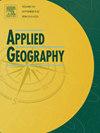Shrinking cities in China's urban network: a data-driven exploration of migration and investment flows
IF 5.4
2区 地球科学
Q1 GEOGRAPHY
引用次数: 0
Abstract
Shrinking cities in China have garnered growing academic attention. However, most studies analyze these cities independently, overlooking their roles within broader urban networks. This study utilizes intercity migration and investment flow data to explore the roles of shrinking cities in China's urban network, focusing on flow patterns, network connectivity, and spatial interdependencies. The results show that migration outflows from shrinking cities are concentrated in provincial capitals, whereas investment flows predominantly target national economic centers such as Beijing and Shanghai. Shrinking cities demonstrate higher connectivity in migration networks than in investment networks, often functioning as peripheral nodes with constrained influence. Distinct spatial patterns between migration and investment flows reveal significant regional disparities, highlighting uneven economic interdependencies across China's regions. We propose a comprehensive framework integrating flow pattern analysis, network metrics, and spatial association modeling to assess shrinking cities' roles in regional population and capital redistribution. The findings offer critical insights into the network roles of shrinking cities, supporting the formulation of coordinated development strategies across China's regions.
中国城市网络中萎缩的城市:数据驱动的移民和投资流动探索
中国不断缩小的城市已经引起了学术界越来越多的关注。然而,大多数研究都是独立分析这些城市,而忽略了它们在更广泛的城市网络中的作用。本研究利用城际人口迁移和投资流动数据,探讨城市收缩在中国城市网络中的作用,重点关注流动模式、网络连通性和空间相互依赖性。结果表明,萎缩城市的移民外流集中在省会城市,而投资流动主要针对北京和上海等国家经济中心。萎缩的城市在移民网络中表现出比在投资网络中更高的连通性,往往作为影响有限的外围节点发挥作用。不同的移民和投资流动空间格局揭示了显著的区域差异,凸显了中国各地区经济相互依赖的不平衡。我们提出了一个综合流动模式分析、网络度量和空间关联模型的框架来评估萎缩城市在区域人口和资本再分配中的作用。研究结果为研究萎缩城市的网络作用提供了重要见解,为制定中国各地区协调发展战略提供了支持。
本文章由计算机程序翻译,如有差异,请以英文原文为准。
求助全文
约1分钟内获得全文
求助全文
来源期刊

Applied Geography
GEOGRAPHY-
CiteScore
8.00
自引率
2.00%
发文量
134
期刊介绍:
Applied Geography is a journal devoted to the publication of research which utilizes geographic approaches (human, physical, nature-society and GIScience) to resolve human problems that have a spatial dimension. These problems may be related to the assessment, management and allocation of the world physical and/or human resources. The underlying rationale of the journal is that only through a clear understanding of the relevant societal, physical, and coupled natural-humans systems can we resolve such problems. Papers are invited on any theme involving the application of geographical theory and methodology in the resolution of human problems.
 求助内容:
求助内容: 应助结果提醒方式:
应助结果提醒方式:


